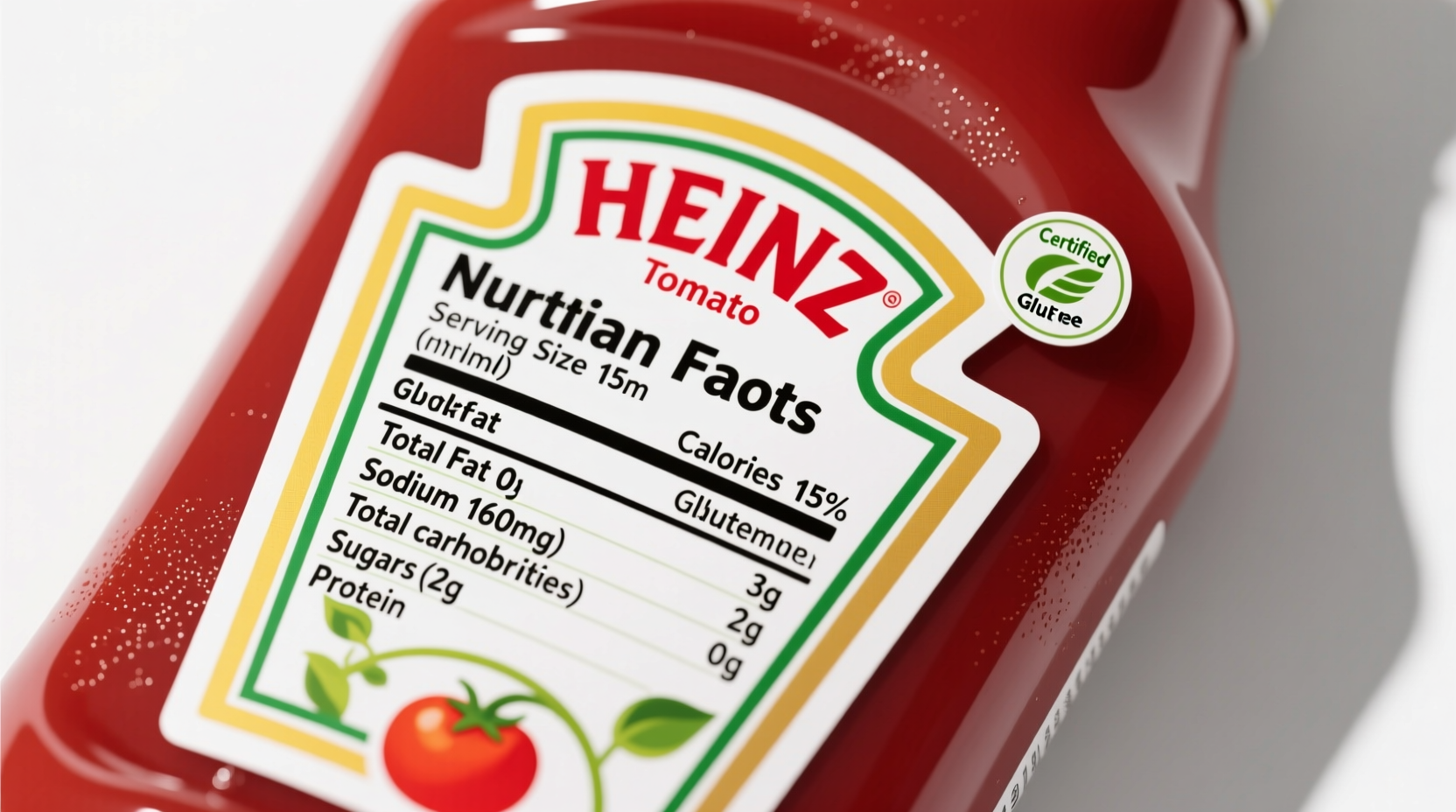When you reach for that familiar glass bottle of Heinz Tomato Ketchup, you're probably thinking about flavor rather than nutrition. But for health-conscious consumers, those nutritional details matter significantly. This comprehensive guide delivers the complete nutritional profile you need, explains what those numbers mean for your diet, and provides practical usage tips backed by authoritative data sources.
Complete Nutritional Breakdown Per Standard Serving
Understanding ketchup nutrition requires examining the full nutritional profile, not just isolated numbers. The standard serving size for ketchup is one tablespoon (15ml), though many people use more without realizing the cumulative effect on their daily intake.
| Nutrient | Amount Per Tbsp (15ml) | % Daily Value* |
|---|---|---|
| Calories | 20 | 1% |
| Total Fat | 0g | 0% |
| Sodium | 160mg | 7% |
| Total Carbohydrates | 5g | 2% |
| Dietary Fiber | 0g | 0% |
| Sugars | 4g | 8%** |
| Protein | 0g | 0% |
| Vitamin C | 4% DV | 4% |
| Potassium | 2% DV | 2% |
*Percent Daily Values are based on a 2,000 calorie diet. Your daily values may be higher or lower depending on your calorie needs.
**% Daily Value for added sugars based on FDA recommendation of less than 50g per day
Ingredient Analysis: What's Really in Heinz Ketchup
Heinz Tomato Ketchup's ingredient list is relatively straightforward compared to many processed foods: tomatoes, distilled vinegar, high fructose corn syrup, corn syrup, salt, spice, onion powder, and natural flavoring. Let's examine what each component contributes to both nutrition and flavor:
- Tomato concentrate - Provides lycopene, a powerful antioxidant associated with heart health and cancer prevention. According to the USDA FoodData Central database, tomatoes contribute most of the vitamin C content.
- Vinegar - Adds tanginess while helping preserve the product without artificial preservatives.
- Sugars (high fructose corn syrup and corn syrup) - Contribute to the 4g of sugar per serving. This represents approximately 8% of the American Heart Association's recommended daily limit for added sugars.
- Salt - Accounts for the 160mg of sodium per serving, which is 7% of the FDA's recommended daily limit of 2,300mg.
- Spices and natural flavoring - These include onion powder and proprietary spice blends that create Heinz's distinctive taste without adding significant calories.
Health Implications: What the Numbers Mean for Your Diet
While ketchup might seem nutritionally insignificant due to small serving sizes, regular use can contribute meaningfully to your daily intake of certain nutrients. Understanding these implications helps you make informed choices:
Sodium Content in Context
The 160mg of sodium per tablespoon represents 7% of the FDA's recommended daily limit. For individuals managing hypertension or following a sodium-restricted diet, this becomes significant when ketchup is used liberally. The American Heart Association recommends no more than 1,500mg of sodium daily for optimal heart health, making one tablespoon of ketchup approximately 10% of this stricter limit.
Sugar Considerations
With 4g of sugar per tablespoon, Heinz ketchup contains more sugar than many people realize. The product contains no fiber to offset this sugar, meaning it affects blood glucose levels more directly than whole fruits. For comparison, this is equivalent to about one teaspoon of sugar per serving. The Centers for Disease Control and Prevention notes that added sugars should comprise less than 10% of daily calories, making ketchup consumption worth monitoring for those with diabetes or prediabetes.

Practical Usage Guidance for Different Dietary Needs
Understanding how to incorporate ketchup into various dietary patterns transforms this common condiment from a potential concern to a manageable part of balanced eating:
For Heart-Healthy Diets
If you're monitoring sodium intake, consider using just half a tablespoon instead of a full serving. This simple adjustment reduces sodium intake to 80mg while still providing flavor. The American Heart Association recommends finding lower-sodium alternatives when possible, but for many, moderate use of regular ketchup fits within heart-healthy eating patterns.
For Diabetes Management
The American Diabetes Association suggests being mindful of condiments with added sugars. When using ketchup, pair it with high-fiber foods like whole grain bread or vegetables to help moderate blood sugar response. One practical tip: measure your ketchup rather than free-pouring to maintain awareness of your intake.
For Weight Management
While ketchup is relatively low in calories (20 per tablespoon), those calories can add up quickly with liberal use. Registered dietitians often recommend using spray bottles to distribute ketchup more evenly with less volume, maximizing flavor while minimizing calories.
Comparison with Alternative Options
Consumers today have more ketchup options than ever. Understanding how standard Heinz compares to alternatives helps make informed choices:
| Product | Calories per Tbsp | Sugar per Tbsp | Sodium per Tbsp |
|---|---|---|---|
| Heinz Regular | 20 | 4g | 160mg |
| Heinz No Sugar Added | 15 | 1g | 190mg |
| Heinz Organic | 20 | 4g | 150mg |
| Store Brand Regular | 20 | 4g | 140-180mg |
| Salsa (medium) | 10 | 2g | 180mg |
As shown in the comparison table, while sugar-free options reduce sugar content, they often increase sodium to compensate for flavor. Organic versions typically have similar nutritional profiles to regular ketchup but come from organically grown ingredients. For those specifically concerned about sugar, salsa provides a lower-sugar alternative with similar flavor complexity.
Historical Context of Ketchup Nutrition
Understanding how ketchup nutrition has evolved provides valuable perspective. In the early 20th century, ketchup formulations varied widely, with some containing dangerous levels of preservatives. The 1930s saw standardization of ketchup recipes, establishing the tomato-vinegar-sugar-salt foundation we recognize today. According to historical food records from the National Library of Medicine, sugar content in commercial ketchups has remained relatively consistent since the 1950s, while sodium levels have decreased slightly due to changing dietary recommendations.
Practical Tips for Mindful Ketchup Consumption
Instead of eliminating ketchup entirely, these evidence-based strategies help incorporate it thoughtfully into your diet:
- Measure your servings - Use a measuring spoon to understand what one tablespoon actually looks like
- Create flavor layering - Mix ketchup with mustard or hot sauce to extend flavor with less volume
- Explore homemade options - Making your own allows control over sugar and sodium content
- Consider timing - Pair ketchup with high-fiber foods to moderate blood sugar impact
- Check expiration dates - Older ketchup may separate or lose flavor, leading to overuse to compensate
Frequently Asked Questions
Is Heinz ketchup suitable for diabetics?
Heinz ketchup contains 4g of sugar per tablespoon, which can affect blood glucose levels. Diabetics can include it in moderation by measuring portions (½ tablespoon instead of full), pairing with high-fiber foods, and accounting for the carbohydrates in their meal planning. The American Diabetes Association recommends being mindful of condiments with added sugars but doesn't prohibit ketchup when used thoughtfully.
How does Heinz ketchup compare to other popular condiments nutritionally?
Compared to other condiments, Heinz ketchup has moderate sugar (4g per tbsp) but lower calories than mayonnaise (90 cal/tbsp) or barbecue sauce (50 cal/tbsp). It contains more sugar than mustard (0g) but less sodium than soy sauce. Salsa offers a lower-sugar alternative (2g per tbsp) with similar flavor complexity. Each condiment has different nutritional profiles that fit various dietary needs.
Does Heinz ketchup contain high fructose corn syrup?
Yes, standard Heinz Tomato Ketchup contains both high fructose corn syrup and corn syrup as sweeteners. The product label lists these as the third and fourth ingredients after tomato concentrate and distilled vinegar. Heinz also offers a "No Sugar Added" version that uses alternative sweeteners instead of corn syrups.
Is there a low-sodium version of Heinz ketchup available?
Heinz does not currently offer a specifically labeled "low-sodium" ketchup. However, their "No Sugar Added" version contains 190mg of sodium per tablespoon (slightly higher than regular), while their Organic ketchup has 150mg per tablespoon (slightly lower). For significant sodium reduction, consider making homemade ketchup where you can control the salt content, or use alternatives like salsa which typically contains 180mg sodium per tablespoon.
How much ketchup do Americans typically consume?
According to USDA Economic Research Service data, the average American consumes approximately 2-3 pounds of ketchup annually. This translates to roughly one teaspoon per day, though consumption varies widely. Many nutritionists note that actual usage often exceeds the standard 1-tablespoon serving size listed on nutrition labels, with restaurant servings frequently containing 2-3 times the standard portion.











 浙公网安备
33010002000092号
浙公网安备
33010002000092号 浙B2-20120091-4
浙B2-20120091-4